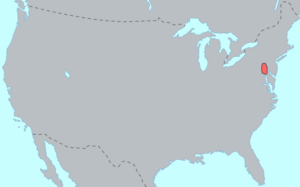Susquehannock language facts for kids
Quick facts for kids Conestoga Language (Susquehannock) |
|
|---|---|
| Conestoga Language | |
| Native to | New York, Pennsylvania, Maryland, West Virginia Northeastern United States |
| Ethnicity | Susquehannock |
| Language family |
Iroquoian
|
| Linguist List | sqn |

Present Day Majority Distribution of the Conestoga Language (Susquehannock)
|
|
The Susquehannock language, also known as Conestoga, was spoken by the Native American people called the Susquehannock or Conestoga. It is part of the Iroquoian language family.
Contents
Learning About the Susquehannock Language
We don't have a lot of information about the Susquehannock language today. Most of what we know comes from a special list of words.
The Campanius Vocabulary
This list is called the Vocabula Mahakuassica. It was written by a Swedish missionary named Johannes Campanius. He wrote it in the 1640s in New Sweden, which is now part of the United States.
Campanius's grandson, Thomas Campanius Holm, published this list in two books. These books came out in 1696 and 1702. Later, in 1834, Peter Stephen Du Ponceau translated the 1702 book from Swedish into English.
What the Vocabulary Tells Us
The Vocabula Mahakuassica has just over 100 words and phrases. Even with this small amount of information, experts can learn a lot.
Linguist Marianne Mithun studied this data. She believes Susquehannock is a Northern Iroquoian language. This means it is closely related to the languages spoken by the Haudenosaunee Confederacy.
Susquehannock in Place Names
Even though the language is no longer spoken, its words live on in some places. Many place names in the area where the Conestoga people lived come from their language.
Examples of these names include Conestoga, Juniata, and Swatara. A book from 1928, Indian Villages and Place Names in Pennsylvania, written by Dr. George P. Donehoo, lists many of these names.
After 1763, some of the remaining Conestoga people joined other nations. They became part of the Haudenosaunee Confederacy. The Conestoga language continued to be spoken for a while after that time.

